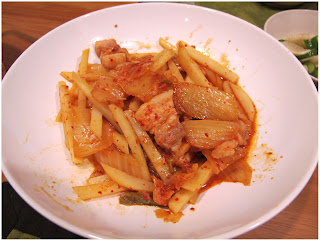The Japanese seem to have this amazing ability to take anything from a foreign culture, improve it, and call it their own. A Hambāgu is a perfect example.
So what is a Hambāgu? It is "a popular Salisbury steak dish in Japan. It is made from ground meat with finely chopped onion, egg and breadcrumbs flavored with various spices, and made into a flat, circular shape about a centimeter thick and 10 to 15 cm in diameter." (Wikipedia) Do not confuse a Hambāgu (the topic of this post) with Hambāgā (the hamburger sandwich), although they are similar in appearance and both very common in Japan.
I search the Internet for a good Hambāgu recipe and finally settled on this one from Marc Matsumoto of No Recipes because it sounds pretty interesting to add silken tofu to the patty. I didn't change the recipe much except that I used a mix of ground beef and pork instead of just beef as in the original recipe and I added mushrooms in the sauce. I probably over-reduced the red wine because as you can see in the picture there wasn't a lot of sauce (I love to eat the sides with the sauce), and the fact that I added mushrooms probably soaked up some of it as well; but other than that, this recipe is awesome. I like how it uses both caramelized and fresh onions and the silken tofu does make the patty more moist and tender. I also made 偽主婦ki琪's cauliflower mesh as a side and it goes wonderfully with my Hambāgu!
Adapted from the recipe of Marc Matsumoto
Difficulty: Intermediate
For the patty:
1 large egg
1 small onion, finely diced
1 large clove garlic, finely chopped
1 pound ground beef (I used a mix of both beef and pork, about a 7:3 ratio of beef to pork)
180 grams (6 silken tofu
1 cup panko
2 tablespoons ketchup
1 tablespoon oyster sauce
1 tablespoon parsley, finely chopped
1 teaspoon soy sauce
1/4 teaspoon black pepper
For the sauce:
100 grams button mushrooms, sliced
1/2 cup dry red wine
1/4 cup ketchup
1/4 cup water
2 tablespoons tonkatsu sauce (Worcestershire sauce works too)
1 tablespoon demi-glace (optional)
Method:
1. Add a tablespoon of oil to a frying pan and sauté the mushrooms. Set aside.
2. Add a little of oil to the frying pan and sauté half the onions and all of the garlic until medium brown and caramelized. Let it cool to room temperature.
3. Combine the meat, tofu, sautéd onions, raw onions, panko, egg, ketchup, oyster sauce, parsley, soy sauce and black pepper in a large mixing bowl and knead all the ingredients together until it is uniform in color and sticky in texture. Mold into 1" thick patties.
4. Add a little bit more oil to the frying pan that you fried the onions in and place over medium heat. Fry them until they have formed a dark brown crust on one side, then use a spatula to carefully flip them over and brown the other side.
5. After you've fried all the patties, drain off any excess oil (but don't wash the pan as the brown stuff is what will give your sauce flavor). Add the red wine and boil until it's reduced by about half in volume. Add the ketchup, water, tonkatsu sauce, and demi-glace and stir to combine. Place the patties and mushrooms back into the pan, cover, and cook for 7 minutes, flipping them over once in the middle. Cook uncovered for another 3 minutes to thicken the sauce a little.
6. Immediately serve with fresh tomatoes, steamed broccoli and cauliflower mesh. You can also use other sides as you wish.
Let's take a look at the Hambāgu from other members!






























































